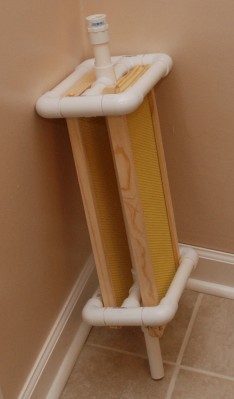Screw wax is a miracle of woodworking. The original woodscrews were probably medieval or earlier. There is debate on when they were first used. I don’t know the correct time, but I bet they were universally hated until someone discovered screw lube.
With or without a pilot hole, by power tool or hand, waxing a screw makes it go in so much smoother and easier. No stripped phillips slots, no broken off heads, and less arm ache if doing it by hand. I picked up a little tin of screw wax a few years back, and it has become my best friend for doing anything finer than 2×4 construction. I love the stuff so much, I wanted to create my own. After all, what is having a backyard full of bees good for if not making your own beeswax products?!
My mustache wax experiments told me I wanted a few parts wax to a single part of something with a lower melting point. Beeswax alone is just too hard to be really useful, so I chose petroleum jelly. I had 32g of wax in this little puck. I wanted to start with a 5:1 ratio, but my scale had issues measuring the jelly weight. Not sure why, but I guessed at somewhere between 5 and 10 grams.
A soda can made an excellent disposable double boiler. Once melted and consistent I let the contents set. I wanted to test the wax before pouring it into a bunch of small containers. I broke out some commercially bought wax, my attempt at screw wax, and straight beeswax. A finger nail impression, while not exactly a rockwell hardness test, showed my version to be similar to the store bought stuff. Beeswax barely leaves an impression with your nail. Screws seem to pick it up just like the commercial stuff too.
Satisfied with the results I remelted the puck and poured it into small 2oz metal tins with nice screw tops. I ended up having to do a second batch to get 4 tins full. Between my dad, my father-in-law, and myself, I needed at least 3. Two tins for me probably represents a 10 year supply. Who knows though, with labels that snazzy, I might find myself reaching for it even more.









































